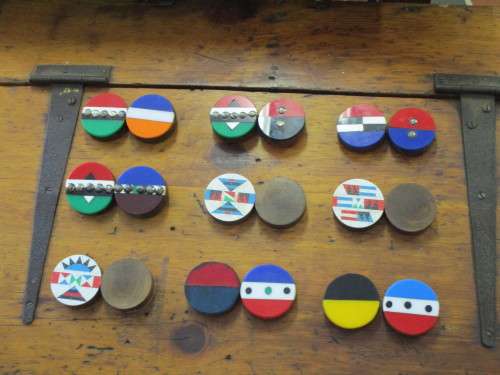
ZULU Ear plugs (Amashaza) For Sale Only 4 pairs left
Check my rate
| Main centres: | 1-3 business days |
| Regional areas: | 3-4 business days |
| Remote areas: | 3-5 business days |

| Main centres: | 1-3 business days |
| Regional areas: | 3-4 business days |
| Remote areas: | 3-5 business days |
*** Postage to any Postnet Branch nationwide included ***
We have a fairly RARE find, with 9 Pairs of ZULU EARPLUGS (Amashaza) For Sale @ R1450.00 per pair.
All are individually hand-made, having a diameter of 5.5cm and a width of between 1.75 and 2cm.
As pictured, going from left to right, top to bottom are Pairs 1 to 9: Each pair has been placed to show both sides of the ear plug:
Pair 1 - 4 :
The first 4 pairs of amashaza plugs are made from a combination of a South African soft wood, iziqhaza, Perspex, glue and are inset with metal upholstery nails – circa 1960-1980;
Pair 5 - 7 : SOLD
The next 3 of the pairs of amashaza plugs are inlaid with geometric vinyl designs circa 1950. The earplugs are made from wood, overlaid – in this instance - on one side only, with brightly coloured designs of vinyl cut from 'Marley' floor tiles. These finely worked mosaic overlays are glued and pinned in place.
Pair 8 - 9 : Pair 9 SOLD
The last 2 pairs of amashaza plugs are made from a combination of wood, Perspex and glue – circa 1960-1980.
The Zulu ear-piercing ceremony (Qhumbuza) was performed on a child before reaching puberty - the first of number of acts denoting the ritual transition from childhood to adulthood. Piercing the ear lobes served as a mark of change; the absence of pierced ears denoted one was still a child, and such persons were considered unable to hear and understand.
Since the 1950s, the Qhumbuza practice has lost its ritual and symbolic meanings. Earplugs become cosmetic for girls and fashionable for men and women who continue to wear them during special events and important ceremonies.
The colors used in ear-plug design often indicate the wearer’s region, clans, and social status. Usually, the designs imitate beadwork patterns, presented in three bands, glued onto the wood. The motifs are inspired from nature, basketry, and pottery.
Some colors and motifs are specific to a particular region like the Msinga region, popular for its seven colors sequence (Isishunka) and four fixed color sequences (red, black or dark blue, white and green) called uMzansi.